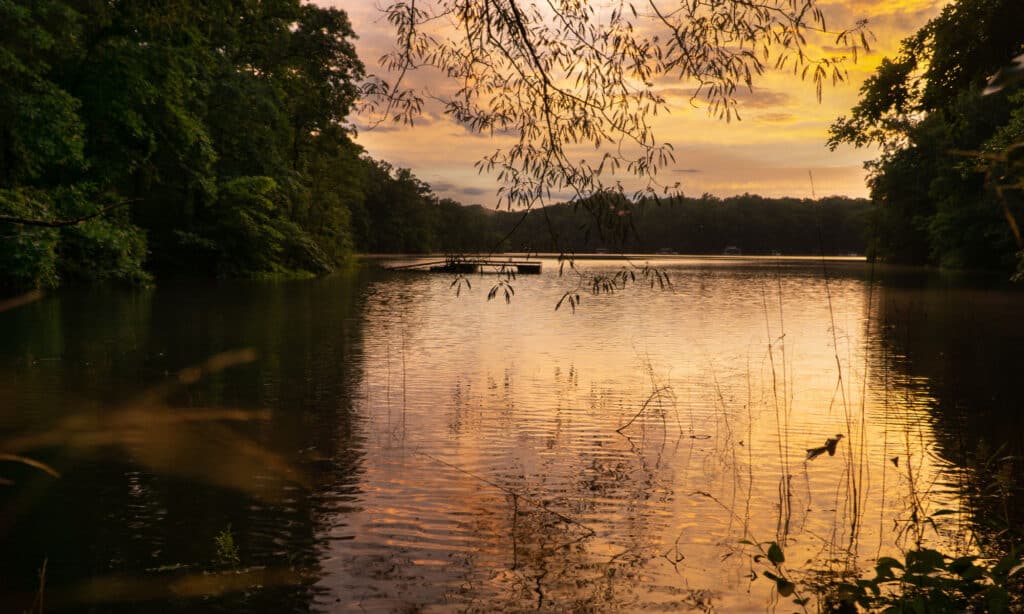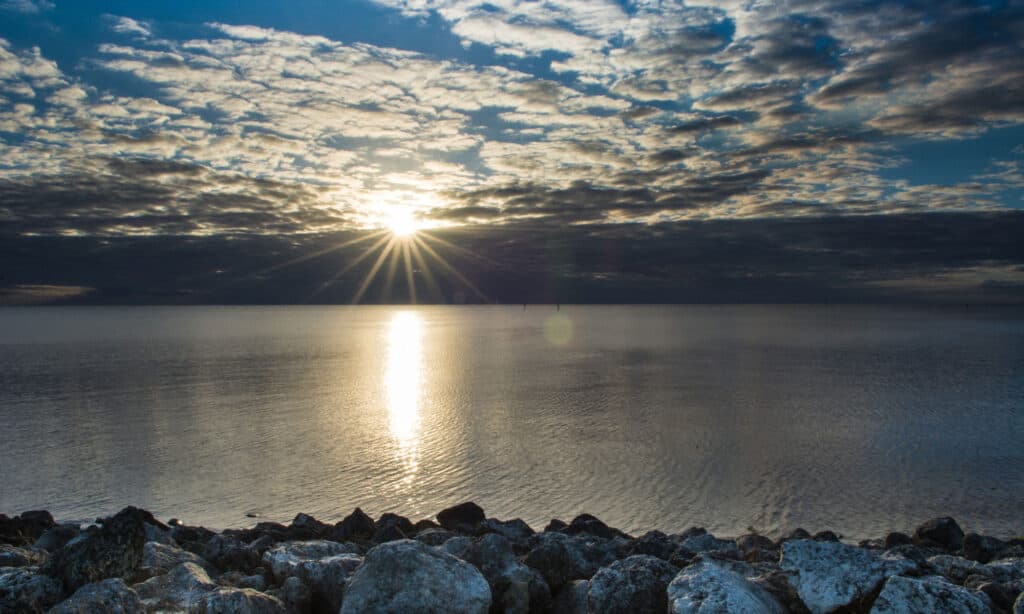Snakes occur everywhere in the United States. From forests to deserts, and even water sources, these snakes inhabit a wide array of environments across the country.
Next time you are swimming in your favorite lake, keep an eye out for snakes, as there are 15 aquatic species in the country. You will, however, be relieved to hear that the United States only has one deadly water-dwelling snake, so it’s not likely a concern.
Of the venomous snakes found in the United States, the cottonmouth, sometimes known as the water moccasin, is the only dangerous snake found in the country that lives predominantly in or near water.
Water snakes can be found near any significant water source, including rivers, lakes, ponds, and marshes, though they prefer quieter environments. With that in mind, we need to know where these snakes thrive so we can be on the lookout for them. Below, we will explore the 10 most snake-infested lakes in the United States.

The Most Snake-Infested Lakes in the United States
Lake Hartwell, Georgia

You can find the Georgia copperhead snake in or around Lake Hartwell.
©iStock.com/Ashley Strickland Photography
When visiting the Lake Hartwell area, you will undoubtedly encounter a variety of species, but one, in particular, you may want to avoid: the eastern copperhead. They live in a wide variety of habitats, from forests to rocky areas. They tend to prefer dryer areas with leaves and brush for camouflage but seem pretty common around Lake Hartwell.
Eastern copperheads have a gray to tan base color with reddish-brown hourglass-shaped markings. Viewed from the side, they often look like chocolate kisses. The bright copper color of their heads is where they get their name.
However, the shade of copper sometimes varies. It’s better to take note of the distinctive pit viper head and thin neck. People new to the area or inexperienced with snakes on Lake Hartwell may confuse the copperhead with the northern water snake, which has similar colors and markings.
If startled, a copperhead shakes its tail before striking, similar to a rattlesnake and many nonvenomous colubrids. However, most copperhead bites happen when someone steps on or otherwise harasses the snake because their first line of defense is sitting still — hoping you don’t see them.
There are also timber and pygmy rattlesnakes although they cannot be found in the same number as copperheads which are the main pit vipers in the area. Are there alligators in this particular lake? So far none have been spotted. Making it highly unlikely.
Lake Gaston, Virginia

The cottonmouth and copperhead are the most active snakes in or around Lake Gaston.
©EnterTheLight/Shutterstock.com
The copperhead, cottonmouth, and timber rattlesnake are three venomous snake species still found in or near Lake Gaston today. The cottonmouth and copperhead are the most active snakes in this area, but you may also see a timber rattlesnake.
The site of any pit viper usually results in pain, swelling, bruising, and redness at the bite site. Their venom, depending on the species, can contain hemotoxins, cytotoxins, neurotoxins, or a combination of two or three.
The timber rattlesnake is occasionally known as the canebreak rattlesnake or even the banded rattlesnake. Generally spread throughout the eastern region of North America, it is also related to the prairie rattlesnake.
Lake Texoma, Texas

The Texas coral snake occurs in Texoma, but not on the Oklahoma side.
©iStock.com/asiantiger247
Texoma is home to many different species of snakes. As the weather warms up, so do the snakes. There are three types of venomous snakes common around Texoma Lake: Copperhead, cottonmouth, and three rattlesnake species. It’s possible to see a Texas coral snake there, but unlikely because they’re very shy.
One rattlesnake in Texoma is the diamondback rattlesnake. In spite of its name, it doesn’t always have a rattle. What’s more, it isn’t too fussed about its choice of habitat and will live in wooded areas as well as coasts.
Before you approach any snake, take a breath and try to identify it. Texas also has a lot of people willing to help you relocate a snake if needed.
Lake Okeechobee, Florida

Timber rattlesnakes and copperheads are exclusive to North Florida.
©Allison Michael/Shutterstock.com
The South Florida region is home to 34 of Florida’s 46 native snake species, including four of the six venomous species. In addition, South Florida is also home to three non-native species, while timber rattlesnakes are exclusive to northern Florida and copperheads only occur in a small area of the panhandle.
Here soon, Burmese pythons may reign supreme over all other creepy-crawlies in a state teeming with them.
In recent decades, they have grown from a small population in the southern Everglades to the Naples area and even as far north as Lake Okeechobee.
Everything is potential prey: from relatively small wading birds and rabbits to large deer and even alligators. The pattern on their camouflage is nearly perfect. Even experienced snake hunters may have difficulty spotting them when lurking in the grasses and under shrubs.
The Burmese python is an invasive species that has grown so prolific in Florida that it has become a serious threat to many other native species. While we know that some people released their unwanted pet snakes, the biggest problem with Burmese pythons was caused by nature. Specifically, hurricane Andrew in 1992 – the hurricane that devastated Florida also destroyed a breeding facility and released countless snakes.
Floris residents are encouraged to capture and humanely kill Burmese pythons whenever possible.
Lake Erie, Ohio

Lake Erie water snake population is closing in on 12,000.
©iStock.com/becky johnson
The population of Lake Erie water snakes is approaching 12,000. It was the 23rd species to be removed from the federal Endangered Species List in 2011, joining the bald eagle, American alligator, and peregrine falcon. About 300 acres of the inland habitat and 11 miles of shoreline also were protected of the water snake.
The Lake Erie watersnake is a smallish nonvenomous snake native to Lake Erie’s islands. This snake is highly semiaquatic, as its name implies, but spends a good portion of time on land. When it’s in the water, it’s usually within about 150 yards from shore. The body is pale grey to dark brown, with a subtle pattern of darker grey or brown bands.
They spend most of the day foraging amphibians and fish in or near water. The rocky beaches of the Lake Erie islands it calls home provide plenty of opportunities for sunbathing and concealment.
Lake Sweetwater, Texas

Texas has the highest number of species of snakes.
©Michael R Ross/Shutterstock.com
If you’re curious about which state has the most snakes, look no further. The number of species in Texas is the highest. In terms of areas of Texas with a large population, West Texas, Central Texas, and South Texas are excellent places to look for snakes.
The World’s Largest Rattlesnake Roundup attracts an estimated 25,000 visitors to Sweetwater each March, infusing $8.3 million into the local economy. Sweetwater’s history and culture intertwine with the roundup. It all started in 1958 when local farmers and ranchers tried to eradicate the local western diamondback rattlesnake population.
Hunters capture the snakes who compete for the largest ones and take them to the Nolan County Coliseum. However, not everyone is a fan. Ecologists and animal rights activists have criticized the event, but it hasn’t deterred what has become a cultural and economic pillar in Sweetwater, uniting generations of its citizens.
Collinsville Lake, Oklahoma
If you enjoy the lakes in Oklahoma, keep in mind that there is a hidden danger. Cottonmouth snakes are relatively common in the eastern third of the state. Cottonmouths are semiaquatic and spend as much time in the water as on the land. Their favorite prey items are fish and frogs.
They are the only venomous snakes that spend a lot of time in the water in the United States. Cottonmouths, like copperheads and rattlesnakes, are pit vipers. They feature heat-sensing facial pits between their eyes and nose.
These unique pits can detect minute temperature variations, allowing the snake to precisely hit the source of heat.
Other Semiaquatic Snakes in the US
The only truly aquatic snakes are sea snakes, some of which live off the coast of the U.S. However, there are a few other semiaquatic snakes:

Queen snakes can be found throughout the eastern part of the United States.
©Ken Griffiths/Shutterstock.com
- Common Watersnake – Eastern U.S.
- Plain-bellied Watersnake – Southeast U.S.
- Queen Snake – Scattered in eastern U.S.
- Saltmarsh Watersnake – Coast of Gulf of Mexico
Evolution and Origins

Snakes are reputed to have existed for over 100 million years
©Casey K. Bishop/Shutterstock.com
Snakes are a group of reptiles that have been around for over 100 million years and have evolved to become some of the world’s most diverse and specialized predators. The evolution and origins of snakes can be traced back to a group of ancient reptiles known as the Lepidosauria, which lived around 140 million years ago.
Fossil evidence suggests that the ancestors of modern-day snakes were small, agile reptiles with long, slender bodies and flexible ribs. Over time, these reptiles evolved to become more specialized in their hunting strategies, developing longer bodies, stronger muscles, and the ability to swallow prey much larger than themselves.
The evolution of snakes can also be traced through their anatomy. Snakes have several adaptations that make them well-suited for a life of hunting and crawling, including a flexible jaw, long body, and the ability to swallow prey much larger than their heads.
Additionally, snakes have a unique system of internal bones and muscles that allows them to move and manipulate their bodies in ways that other reptiles cannot.
Honorable Mentions: Other Snake-Infested U.S. Lakes
Lake Tahoe, Nevada/California

Don’t be fooled by its pristine beauty–snakes are known to swim about in Lake Tahoe.
©christiannafzger/iStock via Getty Images
Lake Tahoe is most famous for its large size and depth, its stunning location in the Sierra Nevada Mountains, overlapping both Nevada and California and its wealth of recreational activities. There’s one thing about Lake Tahoe you may not have been aware of–its snakes! The lake has lots of non-venomous garter snakes and common water snakes, but also many venomous rattlesnakes. While they are both strong swimmers, these reptiles don’t typically attack people while they are swimming, but it’s good to be aware of their presence.
Lake Martin, Alabama

Lake Martin is a popular lake with water enthusiasts in the state of Alabama in spite of its snakes.
©Inch And A Yard/Shutterstock.com
We all know that the Deep South is a region crawling with all kinds of reptiles. The manmade reservoir Lake Martin which sits along the Tallapoosa River in Alabama covers 40,000 acres with 700 miles of shoreline–plenty of surface area for snakes.
There are multiple venomous snakes you could encounter at Lake Martin like copperheads, timber rattlesnakes, pygmy rattlesnakes, and cottonmouths, with the last being the most numerous. Other nonvenomous snakes include garter and rat snakes. While this information may discourage you, the lake is wildly popular in Alabama, with recreational draws like camping, swimming, fishing, and water sports.
Summary Of The Most Snake-Infested Lakes In The United States
| Highest to Lowest Snake Population | Lake | State |
|---|---|---|
| 1 | Lake Sweetwater | TX |
| 2 | Lake Erie | MI |
| 3 | Lake Okeechobee | FL |
| 4 | Lake Texoma | TX |
| 5 | Lake Gaston | VA |
| 6 | Lake Hartwell | GA |
| 7 | Lake Collinsville | OK |
The photo featured at the top of this post is ©
Thank you for reading! Have some feedback for us? Contact the AZ Animals editorial team.






